Pernicious weed? No: beneficial insect magnet, wildlife buffet, nutrient-rich feed, compost fodder… this superpowered plant is one to welcome into your garden and greenhouse.
Be sure to have some thick, sting-proof gloves at the ready – because I’m going to get you all fired up to grow arguably the most useful of all garden plants. Some despair at even seeing it, while others, like me, revel in its savvy cultivation.
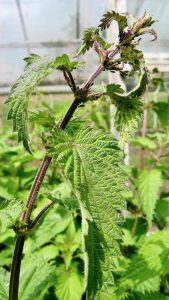
Perennial stinging nettle (Urtica dioica) is now approaching its zenith of usefulness in my garden, despite being slowed down, like much else, by this cool, odd spring. The air is heavy with its distinctive, earthy-cum-spicy scent. Nettles help to improve and enrich my garden and make it more self-sustaining, while bolstering its ecological balance. This is the wild, superpowered ‘weed’ that never stops giving. Wherever I am in my patch, nettles are never far away.
Nettles start their giving in my unheated greenhouse during the winter. I never empty last summer’s tomato pots until spring, by which time they’re replete with young nettles, self-sown into the leaf mould used in my home-made, peat-free potting mix. They do no harm growing slowly during the dark months and, by spring, they’re brandishing one of their improbable superpowers – by harbouring colonies of aphids.
I learnt long ago not to panic at the sight of these ‘pests’, but to rejoice instead. These greenhouse-coddled sap-suckers are meals-in-waiting for the first adult hoverflies to take flight on warm, early spring days. I move a few pots to the entrance of the greenhouse, so the hoverflies can sniff the aphids and lay their pale, pill-shaped eggs amongst them. Days later, the eggs hatch into snot-like larvae, which hoover up aphids at a rate of 50 a day.
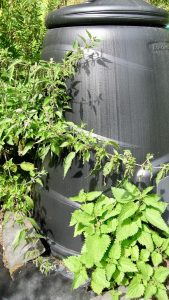
The hoverflies benefit from this early feast of greenfly, while other greenhouse plants, especially my pot-grown strawberries – which are prone to early aphid outbreaks – are then visited by the adult hoverflies drawn to the greenhouse by the nettle-borne aphids. I benefit because the hoverflies also refuel on the first strawberry flowers, pollinating them as they go.
And so my nature-powered greenhouse equilibrium begins. From now until winter, hoverflies will be a constant presence, playing out the seek-food-lay-eggs-eat-aphids-repeat cycle multiple times. This magic isn’t confined to the greenhouse; those ravenous, ugly larval lumps, which morph into darting hoverflies, also zip off into the wider garden, where they lay more eggs.
When tomato-planting time arrives, the nettles go into the composting mix, roots and all. They’re rich in all the main plant foods and help to boost the breakdown of organic matter. I don’t worry about their tough, distinctive yellow roots spreading; they rarely grow more than around 10cm deep and are dead easy to pull up, making free-ranging nettles easy to corral into any spots where you want them.
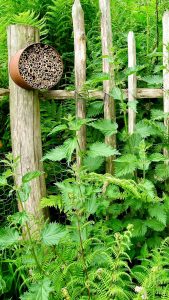
They circle my cool composting bins, soaking up any goodness leaching from the compost, turning it into leafy cut-and-come-again fuel that helps my garden grow. Ditto around my open compost heaps; it’s easy to pluck out the bright roots when it’s time to decant the compost.
If you want to grow nettles somewhere specific, just relocate a few roots. In borders, avoid runaway roots by growing them in a big terracotta pot sunk into the ground, its rim just proud of the soil. For moveable feasts, grow them in large containers, relocating them to where you need hoverflies, such as your food garden.
Most of my wild wonders run the full length of the base of one of my terrace walls. Here nettle roots inhabit the space between slate and soil, where little else would grow. The determined roots do try to sneak out into the beds, but are easily curtailed. Some find their way between the pieces of slate, making it a truly living wall.
Right now there is a linear, dark green forest of nettle shoots (a good-looking foil for spring-flowering bulbs and other plants), which becomes home not just to aphids and their hovering nemeses, but to a plethora of other insects, including ants (which milk aphids for their sugary honeydew), sun-basking shield bugs, ladybirds, beetles and spiders. It is also visited by voles, mice, lizards, slow worms, frogs, toads, slugs, snails and the occasional weasel, which all use it as a sheltered cross-garden transit corridor.
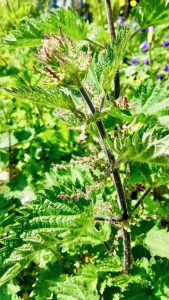
But just weeks from now, they’ll be in for a shock when the mini forest is felled. The first flower buds are just showing on the nettles, so timing is everything; they are prolific self-seeders, so it’s off with their flower-heads well before a single seed ripens – this is where those sting-proof gloves (or even gauntlets) come in.
I have three options when I’m cutting nettles back. The first is to chop them up with secateurs or shears, letting the leafy choppings fall to the soil as an instant, nutrient-rich mulch (the cut stems won’t take root). If I’m removing them, I grab a thick bunch of stems and sever them at the base. These can go straight into/onto a compost heap as an excellent source of ‘greens’ (wilt them in the sun first if there are loads), or they can be chopped up fine and added to a cool, Dalek-type compost bin. The third option allows you to tap into another Urtica superpower by turning them into a nutrient-rich, plastic-bottle-free liquid feed.
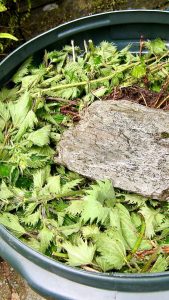
Half-fill a bucket (or larger tub) with water, chop fresh nettle stems into it, press them down, then add a brick or big stone to weigh them down and add more water until they’re submerged. Two to four weeks later, they’ll be transformed into a dark, pungent liquid feed (this is strictly a bottom-of-the-garden brew). Dilute it one part to 10 parts water (strain out any debris with an old cotton tee-shirt) and feed away, then compost the stinky remains. Akin to comfrey, nettles will send up fresh flushes of shoots after each cutting back – which prevents flowering and seeding – so feed-making can be ongoing throughout the summer.
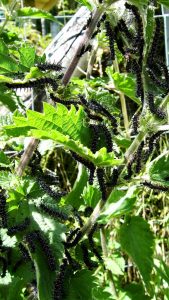
Some metre-high nettle thickets, on the wilder margins of my garden, well away from the pampered terraces, are never cut back, flowering and seeding freely. These offer life-support to our diminishing airborne jewels: butterflies. Commas, painted ladies, peacocks, red admirals and small tortoiseshells, seduced by dahlias, teasels and other butterfly-pullers, will all lay their eggs on nearby nettles. After a few weeks of non-stop, audible chomping (get up close to listen in!), caterpillars morph into fresh airborne gems. Another nettle superpower: they are food for myriad wildlife species in addition to butterflies.
Nettles nourish birds too: seed-eating bullfinches, chaffinches, goldfinches and siskins (currently feasting on dandelion heads outside my window) feed here from summer to autumn. Even in death, nettles go on giving; their dried-out hollow stems are used by some solitary bees and wasps for nest-making, so leave wilder patches well alone.
Fired up? Grab those gloves, grasp the nettle’s superpower, and grow it.
Text and images © John Walker
Find John on Twitter @earthFgardener










